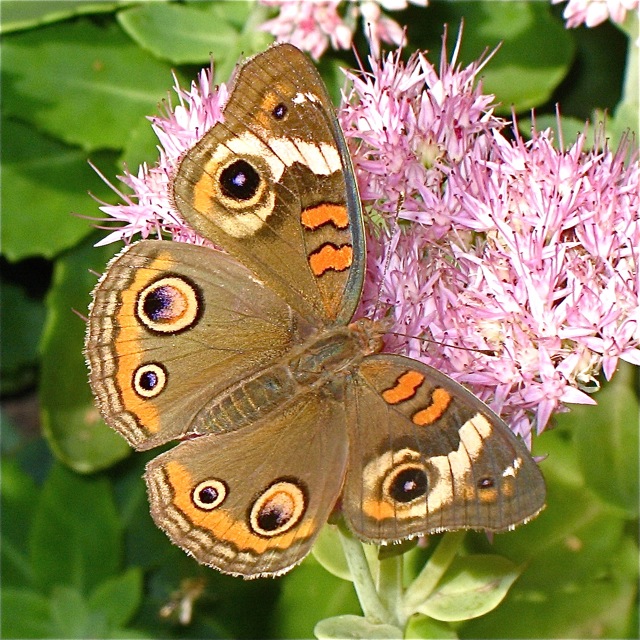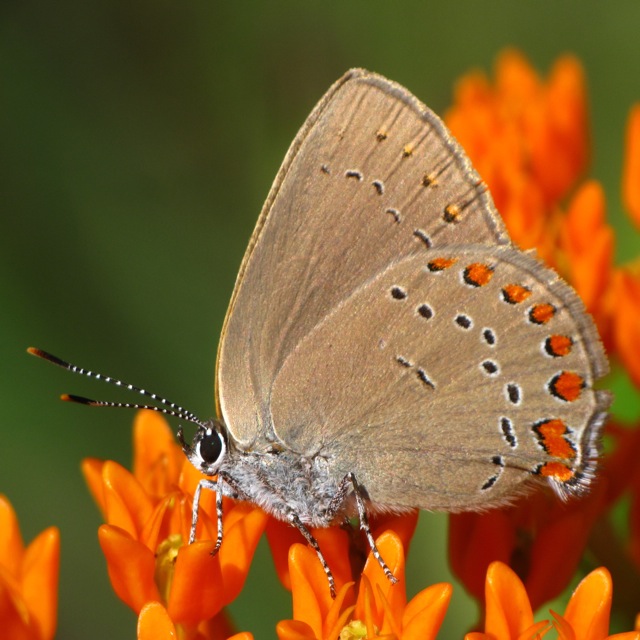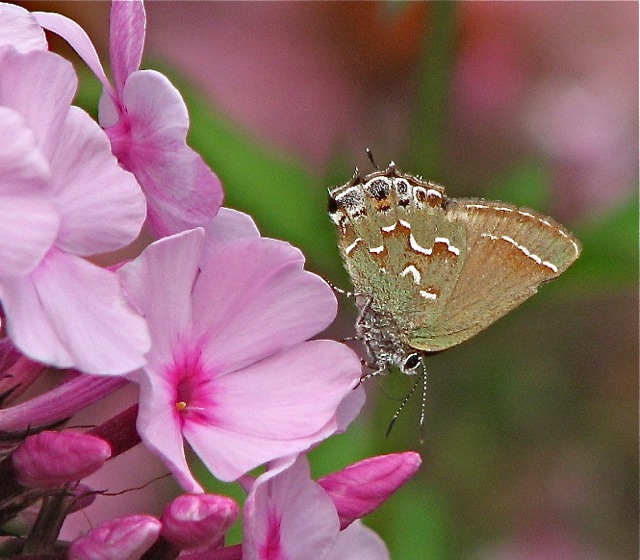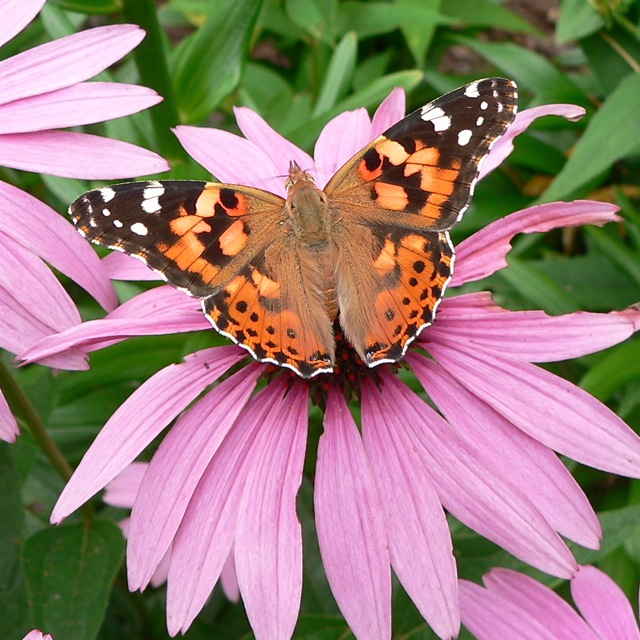Creating a Butterfly Garden

Common Buckeye on Sedum
Many butterfliers, as it turns out, are reformed birders who have finally seen the light. But old habits die hard and they are soon in the grip of the overwhelming need to check-off as many butterfly species as possible. For most of us, seeing a species for the first time, or finding a rare species, is very exciting. But this often requires firing up the old gas guzzler and traveling—sometimes long distances—from home. And what if you cannot, or choose not, to travel? Well, the obvious alternative is to bring the butterflies to you.
There are few things as enjoyable and rewarding to butterfliers as walking into a garden—especially one of your own creation—and seeing butterflies fluttering from flower to flower. While the "listers" are stuck in traffic, you can be sipping your favorite beverage while enjoying the fruits of your labor in comfort. Plus, gardening is an activity that most people can do, AND it’s good exercise. A sure win-win if ever there was one. But before you put that shovel in the ground let’s go over some do’s and don’ts of butterfly gardening.
First, let’s dispense with the notion that you need a large area for a quality butterfly garden. Actually, a few hundred square feet is more than adequate. For folks with very limited space, even some pots will do. The most important things are to choose the right place, select the right plants, and to maintain your garden. So, let’s discuss each of these in turn.

Coral Hairstreak on Butterfly Weed
Where?
Butterflies need sun, sun, and more sun, and plants need sun, water, and care. So, stake out your garden where it is exposed to full sun for at least 6 hours a day, within easy hose range of an outdoor water spigot, and where you can easily see it—perhaps along a frequently traveled walkway, or outside a window where you spend lots of time. After all, if you don’t see the butterflies, are they really there? If you have lots of space, you can create several small gardens that are exposed to sun at different times. On very warm summer days butterflies can be active from 7 AM to 8 PM, so providing sun-bathed nectar sources early and late is a good idea. And although butterflies and other pollinating insects love sun they also need shade in very hot weather. So keep some trees and shrubs near your garden.
Which Plants?
Adults of most species of butterflies sip nectar produced by a wide variety of herbaceous (mostly) and woody plants, whereas caterpillars of most species feed on vegetative parts (usually leaves) of one, or a few closely related, species. If you have enough garden space we recommend that you select plants that provide food for both adults and caterpillars. But before purchasing your plants you may want to confer with local butterfliers and master gardeners about what works best in your area. (For example, flowers that attract lots of butterflies in Cape May could be very disappointing in Sussex County.) Once your garden is established you can apply to NABA for garden certification.

Juniper Hairstreak on Phlox
It is also very important that you keep as much native vegetation— from grasses to trees—in your yard as possible, as many provide food for butterfly and moth caterpillars. This includes plants that many people disdainfully refer to as weeds. So please don’t convert that patch of wild-looking natural habitat to lawn. You may come to rue the day you cut down that patch of bluestem grass and seedling Black Cherries and Sassafras. (Actually, you should consider doing the exact opposite—letting some of your lawn go natural!) Folks living in suburbia should check with the zoning official for possible yard maintenance requirements as many municipalities are run by conformists who insist on well-maintained lawns. No untamed wilderness—thank you! You may also want to discuss your plans with neighbors. Perhaps you can persuade them to do the same. Wouldn’t that be nice! Less to maintain, less air and noise pollution, and better for wildlife. What’s not to like? And for those of us who live in the country with no close neighbors to complain about your weeds—no problem.

Home Garden
How Much Maintenance?
Maintaining a garden does require lots of work, which is why the inexperienced gardener should start off small. Failure to generously water your garden every rainless day is the most common cause of plants dying (especially new ones), which may lead to garden failure and abandonment. Many gardeners in NJ also wage an unrelenting (and often losing) war with deer. Just one deer can decimate a garden overnight, as many plants that attract butterflies also attract deer. Therefore, if you have lots of deer in your area, you may need to fence your garden or your entire yard. If not, you will have to be vigilant in treating your plants with one of the readily available deer–repellent mixes. Again, you may want to ask your local master gardener and butterfliers as to what product is most effective. You can also try and select more plants that are listed as deer resistant, although deer of course cannot read plant labels and often happily munch away on supposedly distasteful species.
And then there is weeding. Some weeds are of no value to butterflies and aggressively compete with the plants you have nursed and coddled. Laying down about 3 inches of mulch (preferably undyed hemlock mulch) will help inhibit weed growth. Master gardeners may have some additional advice on this point.
We also recommend leaving some leaves and other debris in your garden under which caterpillars can hide during the day, and (for some species) shelter over the winter. Neat is not necessarily good.
Much more information about how to manage your garden in the fall to protect butterflies and other garden insects is found on the Leave the Leaves! page of the Xerces Society's website.

Painted Lady on Purple Coneflower
What About Chemicals?
We do not recommend the indiscriminate use of insecticides—or of herbicides, because herbicides often contain chemicals that are harmful to insects, including butterflies, and are not specific to the intended targets. However, the careful application of herbicides is sometimes a necessary evil. Although hand-pulling small patches of invasive species is usually the best alternative, large patches of very aggressive invasive plants such as Mugwort and Autumn Olive may require repeated treatment with the appropriate herbicide (and possibly the services of a professional). Be sure to thoroughly research the issue before selecting and applying any herbicide or insecticide. So-called “neonic” insecticides are especially deadly to pollinators and should always be avoided — learn more info about neonicotinoid pesticides.
Other butterfly-friendly features
Overripe fruit will attract some species of butterflies that infrequently nectar such as Eastern Comma, Question Mark, Red Admiral, Mourning Cloak, Red-spotted Purple, and Tawny and Hackberry emperors. The fruit can be placed in a shallow tray suspended a few feet off the ground. Please note that the fruit will also attract lots of interesting bees, wasps, flies, moths, and other insects, plus raccoons, opossums, bears, and perhaps the odd neighbor.
On cool mornings butterflies like to bask on reflective surfaces to warm up. So placing some dark rocks around the garden that catch the early morning sun is a good idea.

Great Spangled Fritillary on Butterfly Bush
Many species obtain moisture, and minerals such as salt, from damp soil—especially on warm days. You can create damp areas by periodically hosing down one or more spots, or suspending a bucket or gallon jug with small holes over a sunny, open, spot. Or, place some flat, exposed stones in a partially filled bird bath.
Other benefits of your garden
Maintained butterfly gardens and wild patches can be havens for other insects such as bees, wasps, flies, beetles, true bugs, and moths. Many of these insects will help pollinate not only your flowers but vegetable and fruit crops as well. Providing refuges is especially important because many insects—such as several species of bumblebees—are seriously declining.
Learn much more at the Landscaping for Pollinators page of the Jersey-Friendly Yards website.
Also, gardens and wild areas are used by birds, small mammals, and a few reptiles and amphibians.

Indian Skipper on Pincushion Flower
Taking notes and photographs
Many gardeners keep notes on the butterflies they see. This can be as simple as noting the dates on which adults are seen for year-to-year comparisons, to more complicated endeavors such as noting the number of individuals of each species, sex, species of plant visited, behavior (e.g., basking, nectaring, puddling, mating, egg laying), temperature, rainfall, and time of day. Taking photographs is highly recommended, and easy and inexpensive to do with modern digital cameras.
Books About Butterfly Gardening
Hurwitz, J. 2018. Butterfly Gardening: The North American Butterfly Association Guide, Princeton University Press, Princeton. 288 pp. ISBN 978-0691170343 (flexibound).
Xerces Society and Smithsonian Institution. 1998. Butterfly Gardening: Creating Summer Magic in your Garden. Sierra Club Books, San Francisco. ISBN 0-87156-975-2 (paperback).
Local Sources of Native Plants
Toadshade Wildflower Farm, Frenchtown, NJ (mail order and Hunterdon Land Trust Farmers' Market)
Wild Ridge Plants, Pohatcong, NJ (by appointment)
A more extensive list can be found on the Jersey-Friendly Yards website.
More Info?
A list of nectar plants that attract butterflies in New Jersey.
A list of host plants for butterfly caterpillars in New Jersey.
Information about native plants from the The Native Plant Society of New Jersey.
More information about butterfly gardening is available on the NABA Butterfly Gardens page.